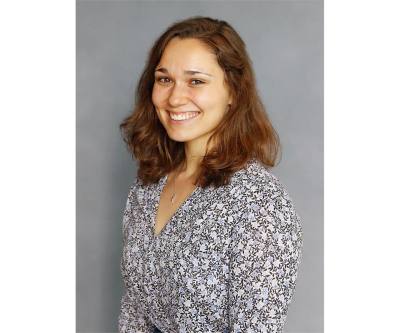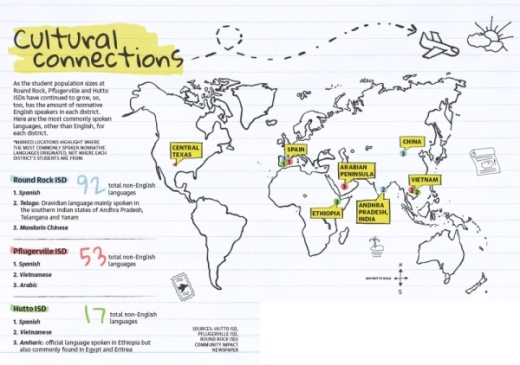In classrooms across Round Rock, Pflugerville and Hutto, a multitude of languages and dialects can be heard, including Hindi, Tamil, Vietnamese, Arabic, Spanish and Amharic. Data from the Texas Education Agency between 2008-18 highlighted double-digit growth in Round Rock, Pflugerville and Hutto ISDs' bilingual and English as a Second Language enrollment, increasing 33.8% in RRISD, 87.1% in PfISD and 67.1% in HISD, respectively.
As it stands, 92 languages other than English are spoken in Round Rock ISD, 53 in Pflugerville ISD and 17 in Hutto ISD—a trend, officials from each district said, that is only expected to continue.
Meeting demands
According to the 2018 American Community Survey 5-Year Estimates released in December, 26.6% of children ages 5-17 in Round Rock speak a language other than English, a slight dip from the 27% recorded in the 2013 ACS data. From 2008-18, however, the Texas Education Agency reported the number of English Language Learners in RRISD increased 22.5%. For students enrolled in both bilingual and English as a Second Language programs, that figure jumped by 33.8%.
"Our tech industry and just the diversification of the Central Texas area has brought in lots of different folks globally into our area," said Maria Green, the director of bilingual and ESL programs at RRISD.
State requirements mandate that when parents enroll a child in school, they must complete a home language survey to evaluate the student’s proficiency in English, Green said. Based on the results, the child is enrolled in either an ESL class or a dual-language program, depending on how developed their English communication skills are. Dual-language programs are typically offered to students with less developed English-speaking skills, Green added.
Dual-language programs have become increasingly popular across the United States in recent years, a system that aims to enrich a child’s native language skills while also fostering their English reading, writing and speaking capabilities. There are two forms of dual-language programs: two-way dual language and one-way dual language.
Two-way dual language programs include both native and nonnative English speakers in an effort to enhance the bilingualism and biliterac
Along with providing for its bilingual programs, Bertha Benedict, the coordinator of RRISD’s bilingual and ESL programs, said the district is looking to expand upon dual-language programs to accommodate nonnative English speakers who do not speak Spanish. It is a challenge, Green added, extending from the state level.
“We don't run a bilingual program in languages [other than Spanish] because we simply can't find the teachers,” Green said. “We should be running [additional] bilingual programs, but there are just not any kind of teachers who can teach this. The state does not have a certification in these languages, so that makes it doubly hard for us to provide.”
To meet growing demands outside of the classroom,
Connecting cultures
Out of RRISD, PfISD and HISD, PfISD has experienced the highest percentage growth in its ELL student population and bilingual and ESL program enrollment from 2008-18, with TEA data reporting an increase of 47.3% and 87.1%, respectively. Out of its total student population in 2018, 22.1% of students qualified as English Language Learners, and 26.2% of students utilized its bilingual and ESL classes.
"We do know we’re diversifying, and we’re seeing it every day; we’re s
Each of PfISD's K-12 campuses offers ESL education, Spence said, with 10 campuses dedicated to one-way dual-language programs and four offering a two-way dual-language curriculum. Dual-language programs operate only at the elementary level, with ESL classes available to middle and high school students to prevent any language barriers from affecting students' comprehension.
“The idea is that we get our kids to be truly, not just bilingual, but also biliterate, so they can read and write in a language other than their native la
For older students immigrating to the United States, Spence said PfISD has put measures in place to ensure that not only is their educational experience not interrupted, but that they are also guided through their immersion into a new culture.
PfISD's Newcomers Program, offered at Connally High School, as a one-year initiative for high school student immigrants to acclimate to the district and expand upon their English language skills. Regardless of where they are zoned or what their native language is, students spend one year learning English and adapting to their new environment before entering their zoned high school.
"It’s essential to help them with the language and the cultural barriers and get them up to speed," Spence said. "And that's for all languages. They join that cohort for that year, and it’s helping them to learn English, to overcome any cultural barriers that there might be."
Growth on the horizon
From 2008-18, the TEA reported Hutto's ELL student population increased 25%. At the same time, HISD's bilingual and ESL education enrollment increased 67.1%. Some of the most common non-English languages spoken in the district, officials said, include Vietnamese, Amharic and Portuguese.
“We embrace that diversity, and we're really proud of the student population that we have,” HISD Superintendent Celina Estrada Thomas said. “I think that's what makes Hutto unique.”
Estrada Thomas said trends highlight growth of nonnative English speakers entering the district at "entry points," such as pre-K and kindergarten, sixth grade and ninth grade.
"When families are going to relocate to a new community and new town, they're going to research those schools, and they're going to try to enter at those particular entry points so that it's less disruptive," Estrada Thomas said. "So kids have a continuous educational experience either at the elementary or the secondary level."
For ESL programs offered throughout HISD, students are assigned an ESL teacher who acts as a case manager for them, said Anna Moreno, a bilingual and ESL specialist in the district.
"We have a dedicated teacher who advocates for the student and provides sheltered instruction, which means they're getting their content in a sheltered manner," Moreno said. "They use different strategies that they're trained in to make sure the students can access the curriculum."
An example of sheltered instruction, Estrada Thomas said, includes using sentence stems—the beginning of a sentence or train of thought—to help enhance student comprehension and aid them in completing full sentences in English.
While Estrada Thomas said she values the work of her district's ESL program, she added that for HISD students, the district’s dual-language program is an essential component of their educational experience and is something students are able to access from elementary school onward.
"The achievement for children who were exposed to multiple languages at the secondary level is just astounding," Estrada Thomas said. "Those children’s progress will just skyrocket as they get older.”
Competing needs
With each district projected to continually grow as the area's overall population increases, representatives from all three districts said dual-language and ESL programs will continue to be offered and expanded upon based on needs assessments.
HISD’s 9th Grade Center is projected to open in August 2021, Estrada Thomas said, adding the district is already looking to hire an additional one or two ESL-certified teachers. But when it comes to bilingual teachers, Estrada Thomas said the limited number available in Texas and the competitive nature of the job search make the process all the more important to incentivize financially.
Green said that she, along with officials from local districts such as Leander and Austin ISDs, has submitted exceptions to the state as part of an ongoing effort to expand upon the kinds of resources available to students, specifically in the number of dual-language programs certified. Green said while Spanish is RRISD's most common language outside of English, the district would benefit from having programs available for Hindi, Korean, Tamil and other prevalent languages.The greatest challenge—Green, Estrada Thomas and Spence each said—is securing the best educators possible from a limited number available.
“The hardest part for us is recruiting those teachers who are certified bilingual," Spence said. "Us, along with the majority of school districts in the state, we’re all kind of vying for a lot of the same teachers to fill those positions.”







